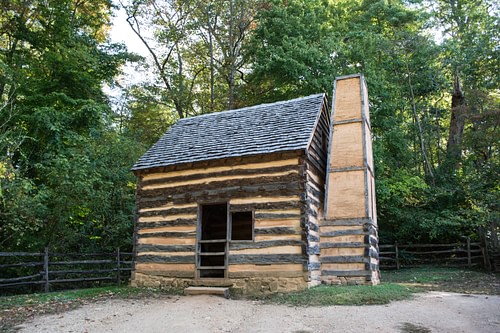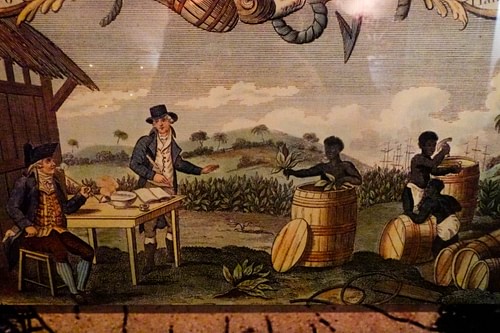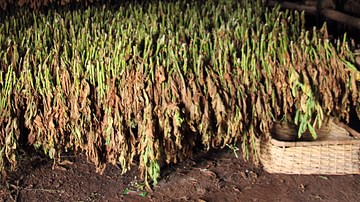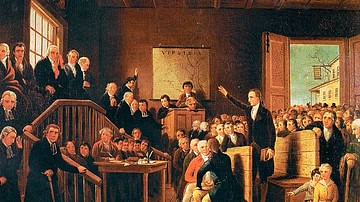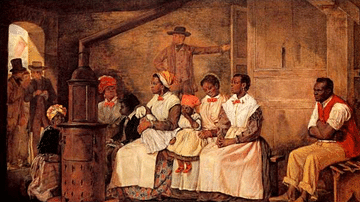African slave life in Colonial British America was far worse than slavery practiced in the Americas prior to the arrival of Europeans. The indigenous tribes took people as slaves in raids, enslaved those convicted of crimes, and traded slaves between tribes but the enslaved were thought to have done something to deserve their fate.
The racial, institutionalized slavery practiced by the English colonists of North America departed from this paradigm by enslaving people who had nothing whatsoever to do with the English, forcing them to work for the remainder of their lives as slaves, and claiming their children as property which could be sold.

The life of a slave in Colonial America differed from colony-to-colony but had one aspect in common: the slave had no rights as a human being and was considered property of the master just as a wagon, mill stone, or axe would be. The white master could, and usually did, treat the slave as just another possession to be used and then disposed of when it no longer functioned as expected.
Africans were often enslaved by those of other tribes and then sold to European slave traders or were kidnapped by Europeans directly. Frequently, those who enslaved fellow Africans found themselves drugged, manacled, and shipped with those they had brought to the slave market. Once arrived in North America, the slave would be worked, in the Southern Colonies at least, from dawn until dusk six days a week, living under the worst conditions, and subject to sale by their owners just as any rake, hoe, or hammer might be. Slave life in Colonial America continued according to this paradigm from c. 1660 until slavery was abolished by the 13th Amendment to the Constitution of the United States in 1865.
Virginia & the First Slaves
The first Africans in North America arrived in Jamestown, Virginia in 1619 aboard a Dutch ship that needed supplies. These 20 or 21 individuals were purchased for the necessary supplies by then-governor Yeardley (l. 1587-1627) who put them to work on his plantation. At this point, the English had no concept of racialized slavery and, in fact, slavery had been abolished in England centuries before, so these first Africans were treated as indentured servants, given a set term of service ending in freedom and reward of land. Scholar David A. Price comments:
Although it is tempting to assume that these first recorded Africans in English America were also the first slaves, there is evidence to suggest they were not. They may instead have had the legal position of indentured servants, like many of the white newcomers, eligible for freedom after completing a period of service. (197)
This paradigm changed in 1640 with the enslavement of an indentured black servant named John Punch. Punch left his master’s service before his time was up, claiming poor treatment, along with two white servants. When the three were caught and returned, the white servants were punished with four years added to their servitude, but Punch was sentenced to lifelong enslavement. After this event, Virginia began passing laws restricting the rights of the black population, instituting slave laws in the 1660’s, and becoming an active participant in the Transatlantic Slave Trade made possible by the Triangle Trade route.
Kidnapping & Middle Passage
The Triangle Trade was a system of exchange of goods and people between Europe, West Africa, and the Americas. Europe shipped items to West Africa (the so-called First Passage) which then shipped enslaved humans to the Americas (the Middle Passage) and the Americas then shipped other items to Europe (Third Passage) and the whole circuit began again in a continuous cycle.
One of the more valuable items imported from Europe to West Africa was guns, shot, and gunpowder which African tribes could purchase through trade in human beings. A tribe which had guns could subdue another, sell them into slavery for more guns, and expand their territory. Although it seemed the Africans were being empowered by this arrangement, it actually only profited the European slavers who received more and more people as slaves.
People would either be kidnapped individually or, usually, in large groups from a village. One tribe would surround a sleeping village at night, set it on fire, and then capture the fleeing inhabitants, marching them at gunpoint to the slave markets on the coast. There they were imprisoned until inspected for sale. Those considered most valuable were separated from the old, weak, or infirm and were branded so they could not be taken back by and exchanged for a “weaker commodity” by those who brought them; those not chosen for sale were killed to keep down costs in food and make more room for the influx of others. Those who brought the slaves to market often found themselves enslaved as described by scholar Oscar Reiss:
The slavers were not above “picking up a bonus”. One tribal chief brought a coffle [a slave caravan of chained blacks] of slaves taken in war. After concluding business, he was invited on board ship for dinner. He was drugged and awakened at sea – now a member of the coffle. (33)
The slaves were packed tightly in the hold of the ship, men chained and separated from women, boys separated from the rest. They were forced to lie on their sides to save space and were given small buckets to relieve themselves in which many could not reach, and which were too small for the numbers below deck to be of any real use anyway. As they made their way across the Atlantic on the Middle Passage, they were allowed above deck in good weather, chained to prevent any leaping overboard. Once the ship reached the Americas, the slaves were unloaded into pens, cleaned and clothed (they had been brought naked, unless a captain ordered them covered), and sold to the colonists.
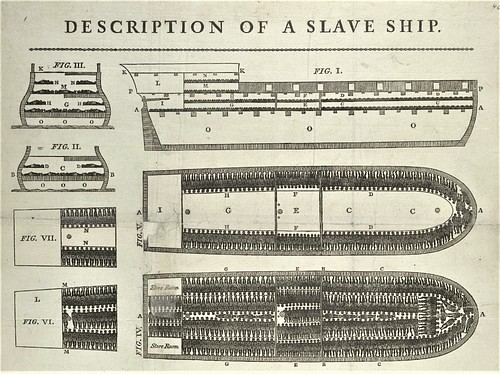
Housing, Food & Clothing
The life of a slave differed between colonies and, within communities, from master-to-master. Colonists in the New England and Middle colonies often had slaves living in their homes or a small shack on the land while those in the Southern Colonies had numerous buildings known as the slave quarters. A typical slave shack is described by Reiss:
It was a one-room frame dwelling with a dirt floor which measured 17 by 20 feet. The cabin had at least one glazed and shuttered window. There was one door with a plate stock lock and a brick chimney with a dirt-floored brick hearth. This provided accommodations for seven or eight adults, with perhaps a sleeping loft for children. (47)
Other cabins were built of logs and had no windows and no door – only a cloth or fur over the doorway – with a fireplace and chimney. There was no furniture, little light, and spaces between logs let in rain or snow.
In New England, the Puritans took better care of their slaves than the plantation owners of the south because they adhered more closely to the biblical example of slaves in the Old Testament who ate and slept with the family. In the Middle Colonies, slaves were fed primarily on corn and yams which were distributed on Sunday while, in the south, rice was the staple food.
Slaves were sometimes allowed to plant and tend private gardens which they had to work on their own time which was only Sunday; the rest of the week was considered the master’s time. Slaves were, of course, not allowed to possess firearms or any form of weaponry and so could not hunt for food. Meat was given to the slaves rarely and always at the master’s discretion.
Clothing was also provided by the master and varied in quality depending on how much he chose to spend. The clothing of one’s slaves could be, but was not always, a sign of one’s wealth and status. So-called “house negroes” who tended children, cooked, cleaned, and served as butlers were always well-clothed as were slaves who regularly accompanied their masters into town. In the Southern Colonies, plantation slaves went nearly naked for most of the year, both men and women wearing little more than a loin cloth.
Marriage & Family
Since slaves were considered property with no rights, marriage - like housing, food, and clothing - was defined by a master who could allow a union, dissolve it, or sell one partner away from the other. Reiss comments:
Slave marriages tended to be unstable and frequently were of short duration. As a group, the only slaveholders who took slaves’ marriages seriously were the Puritans. Adultery was a serious sin and marriage a sanctified institution, even among bondsmen. A marriage ceremony was performed, and the participants were expected to stay together for life. If slaves were sold, the owner tried to sell them as a family unit. Among other groups, only a deeply religious master tried to promote morality and avoid licentiousness among his possessions. (53)
Slaves were encouraged to marry those on their own farm or plantation because, otherwise, they would waste time on Sundays going to visit their spouse. Further, the children of the union belonged to the master of the mother and so one’s male slave fathering children with someone else’s female slave enriched the other and impoverished one’s self.
Slave children were cared for by older siblings, older children, or older women as the mother and father worked six days a week and, in the south, from dawn until dusk. Masters viewed slave marriages as solely for the production of more slaves and couples who did not quickly bear children could have their marriage dissolved and were then married to others.
Within the slave community, family bonds were tight, and people looked out for and took care of one another, especially so considering that often two or more families shared a single cabin. The community as a whole would often look after the children until they were five or six years old and were put to work by the master as messengers, water-bearers, or livery assistants.
Work & Leisure
As noted, a slave worked six days a week, 365 days a year, with holidays off only at an individual master’s discretion. A slave could, and did, work any job which did not involve literacy or firearms. A literate slave was considered a threat and teaching a slave to read was outlawed in most, though not all, colonies. In the New England and Middle colonies, slaves worked the ports, on small farms, or could be skilled crafts and trade people. Slaves in all the colonies worked as cooks, livery grooms, maids, butlers, coopers (barrel-makers), blacksmiths, and candle-makers among other occupations. In the south, slaves were primarily used in agricultural labor in the tobacco and rice fields.
Besides Sundays, the only time off given to slaves was the summer lay-by - the end of the cultivation period on plantations - and Christmas. At Christmas, slaves were given between three to six days off and this was the only time of year they could expect to be given meat and were allowed to play musical instruments, generally speaking.
On Sundays, slaves attended their own or the white peoples’ worship service, told stories, sang and danced, and worked their own gardens if they were allowed to have them. They might also be permitted to make their own furniture or improve their housing and would also play games. Sundays and, especially, Christmas were also leisure times in which slave plots were made to escape or plan insurrection and masters, especially in the south, maintained tighter security at these times.
Dissent & Rebellion
Slaves “rebelled” in many ways throughout the year whether by feigning illness or breaking tools or pretending they had not understood a master’s or overseer’s instruction. At times, however, slave rebellions broke out and, as this was among the colonists’ greatest fears, any such revolt was put down swiftly with harsh punishments following, even for those slaves who had not participated.
The first uprising in the English colonies, instigated and led by African slaves, was the New York Slave Revolt of 1712. New York City had been under Dutch control as New Amsterdam until 1664 when Dutch holdings were taken by the English. The Dutch had allowed slaves many freedoms which were denied by the English who then instituted harsher slave laws and greater restrictions. On the night of 6 April 1712, 23 slaves set fire to a building on Broadway and, when the whites came to put it down, killed them with weapons they had stolen. They were caught, arrested, and executed but over 70 more were jailed and punished.
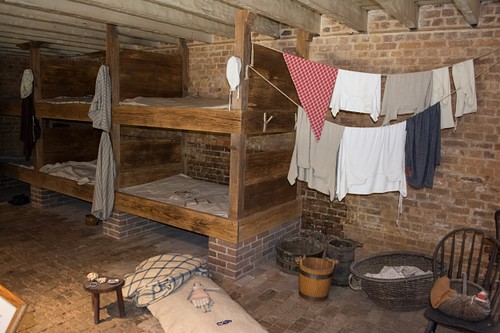
The largest slave revolt in the colonies was the Stono Rebellion of 1739 in South Carolina. A slave named Jemmy led 20 slaves from the Stono River toward Spanish St. Augustine, Florida, where they would find freedom. They raided a warehouse for weapons and began their march, others joining them until they numbered over 100, and then attacked and killed their white masters and destroyed properties. Their attacks slowed their march, and the white militia were able to mobilize and disperse them. 25 white colonists were killed and 30 blacks; but many more slaves were hanged or burned over the course of the following year.
Conclusion
Slaves were allowed to take their master’s place in the colonial militia and then the Continental Army during the American War of Independence (1775-1783) in exchange for their freedom, but this did nothing to end the institution of slavery. Free blacks appear on census records as early as the 1640’s and so the slaves who won their freedom in the war were not considered anything very special.
Between 1800-1850 the New England and Middle colonies slowly abandoned slavery as they became more industrialized and greater pressure was brought to bear by the abolitionists, but it was rigidly maintained in the south. Although the Stono Rebellion is regarded as the largest revolt owing to the participation of over 100 slaves, the most haunting was Nat Turner’s Rebellion of 1831 in Virginia which resulted in the deaths of between 55-60 white people. Turner and his followers were executed but over 200 slaves and free blacks were killed in the aftermath.
The event so terrorized the Southern Colonies that harsher slave laws were instituted, further exacerbating tensions between the southern and northern states that finally erupted in the American Civil War (1861-1865). The Emancipation Proclamation of 1863 freed the slaves in the southern states which were in rebellion but could not be enforced until the war ended. When the north won, the 13th Amendment to the Constitution abolished slavery in the United States in 1865, ending an institution that had existed for over 200 years and enslaved millions under some of the worst conditions recorded in history.
